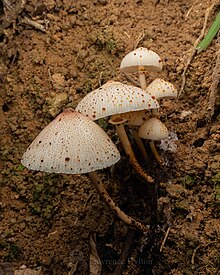| Leucoagaricus lacrymans | |
|---|---|

| |
| Scientific classification | |
| Domain: | Eukaryota |
| Kingdom: | Fungi |
| Division: | Basidiomycota |
| Class: | Agaricomycetes |
| Order: | Agaricales |
| Family: | Agaricaceae |
| Genus: | Leucoagaricus |
| Species: | L. lacrymans |
| Binomial name | |
| Leucoagaricus lacrymans (T.K.A. Kumar & Manim.) Z.W. Ge & Zhu L. Yang (2017) | |
| Synonyms | |
|
Leucocoprinus lacrymans T.K.A. Kumar & Manim. (2004) | |
| Leucoagaricus lacrymans | |
|---|---|
| Gills on hymenium | |
| Cap is campanulate or flat | |
| Hymenium is free | |
| Stipe has a ring | |
| Spore print is white | |
| Ecology is saprotrophic | |
| Edibility is unknown | |
Leucoagaricus lacrymans is a species of mushroom producing fungus in the family Agaricaceae.
Taxonomy
It was first described in 2004 by the Indian mycologists T.K. Arun Kumar & Patinjareveettil Manimohan who classified it as Leucocoprinus lacrymans.
In 2017 it was reclassified as Leucoagaricus lacrymans by the Chinese mycologists Zai-Wei Ge & Zhu-Liang Yang based on phylogenetic analysis.
Description
Cap: 3–8.3 cm wide, starting cylindrical but truncate on the top and expanding to become campanulate to convex and finally flattening with age whilst often retaining a distinct umbo. The surface is white to creamy coloured and covered with minute, flattened (appressed) cinnamon to rusty brown to purplish brown scales which are sparser at the margins but denser towards the centre of the cap where they become more granular (granulose) or slightly velvety (velutinate). The cap margins have striations (sulcate-striate) and are entire, starting incurved before flattening with age and becoming fissile (prone to splitting slightly). The cap edges are often covered with yellow to reddish brown guttation the same as that seen on the stem. The cap flesh is white or whitish and thin (3mm thick) and discolours to a pale orange when cut or a greyish orange with longer exposure on cut surfaces. Stem: 4–12 cm tall and 5-6mm thick running almost equally along the length or tapering slightly towards the top. The surface is white or a dirty white colour and darkens to brownish with age and is velvety when young (velutinous to villose) but has some flattened fibrils when older (appressed-fibrillose). It is often covered with beads of yellow to reddish brown guttation. The interior is hollow and the base of the stem can display white mycelial cords (rhizomorphs). The membranous stem ring is located towards the top of the stem (superior). Kumar and Manimohan note the ring as being white and usually disappearing without a trace (evanescent) whilst Ge and Yang state that it is brown and persistent. Gills: Free without a collar, moderately crowded and white but aging to a yellowish white and then discolouring reddish with age or upon drying. They are thin (up to 4mm wide) and may bulge in the middle (ventricose). The gills are of two or three different lengths and the edges are finely fringed and may be tinted greyish on older specimens. Smell: Indistinct. Spore print: White. Spores: Ellipsoidal to broadly ellipsoidal when viewed from the side and ellipsoidal, ovoid or subglobose front on. They are hyaline and smooth with a distinct germ pore. Dextrinoid. 5-13 x 4.5-11μm. Basidia: 4 spored.
Habitat and distribution
The specimens studied by Kumar and Manimohan were collected in Kerala State, India and were found growing on soil and decaying leaf litter around the base of coconut trees where they were solitary or growing in clusters. Ge and Yang not that the species grows in tropical forests and is known from India and China.
Etymology
The specific epithet lacrymans derives from Latin and means weeping, in reference to the guttation this species presents with.
Similar species
Leucocoprinus zelanicus is noted as being similar however is distinguished by the smooth stem, the lack of guttation on the cap and stem as well as microscopic differences including a smaller spore size.
References
- "Species fungorum - Leucoagaricus lacrymans (T.K.A. Kumar & Manim.) Z.W. Ge & Zhu L. Yang, in Yang & Ge, Mycosystema 36(5): 547 (2017)". www.speciesfungorum.org. Retrieved 2022-07-19.
- "Mycobank Database - Leucoagaricus lacrymans".
- ^ Kumar, T. K. Arun; Manimohan, Patinjareveettil (2004). "A new species of Leucocoprinus from India". Mycotaxon. 90 (2): 393–397 – via www.researchgate.net.
- ^ Yang, Zhu-Liang; Ge, Zai-Wei (2017). "Six new combinations of lepiotaceous fungi from China". Mycosystema. 36 (5): 542–551 – via www.manu40.magtech.com.cn.
- Arun Kumar, T. K.; Manimohan, P. (2009-07-16). "The genera Leucoagaricus and Leucocoprinus (Agaricales, Basidiomycota) in Kerala State, India". Mycotaxon. 108 (1): 385–428. doi:10.5248/108.385. ISSN 0093-4666.
| Taxon identifiers | |
|---|---|
| Leucocoprinus lacrymans | |